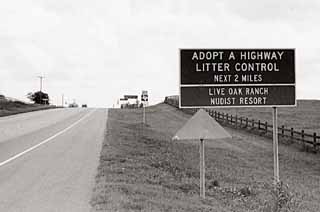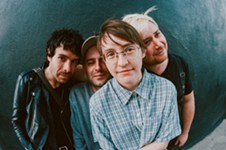Day Trips
By Gerald E. McLeod, Fri., April 5, 2002

Wildflower season in Texas can be just awesome. Fields along the highways are filled with colors, as if the sky had dropped to the earth or the sunshine had become a liquid. Add to this the reds, purples, and other hues and you have a rainbow at your feet.
Texas is a big place with a variety of weather and soil conditions that are conducive to a wide variety of native plant species. The natural wonder of the state's flowering plants is compounded by the state highway department broadcasting tons of flower seeds every year for erosion control, creating an artist's palette of colors and sceneries.
Even in the best of years the crop of wildflowers can be capricious. No man can control the weather and the rain, and sunshine can have the greatest effect of what sprouts and where. Generally speaking, the wildflower blooms begin in the Big Bend area in March and move toward the northeast corner of the state peaking in late April and early May.
Grab the baby and the camera and head for the highways in April, the state's official wildflower month. Here are some hints, but no guarantees, of highways that usually have colorful displays of wildflowers.
TX 29 from Georgetown to Llano is one of my personal favorite drives any time of the year, especially during wildflower season. The mixture of granite hills, scenic pastures, and the Highland Lakes make this the quintessential Hill Country drive. Stop to eat at the Catfish Barge on Inks Lake or head into Llano for barbecue.
FM 1431 was one of the first roads I discovered when I came to Austin, and it's still on my list of favorite drives in Texas. Lots of hairpin turns, scenic views, and places to stop. Even though I always mention this road, I don't think you can blame me for the crowds.
Cuero and DeWitt County lay claim to the "Wildflower Capital of Texas" for just reason. They persuaded the state legislature to make it official in 1999. Mother Nature made it so by putting 1,000 of the state's 5,000 species of native flowers in the county. Cuero is about a hundred miles southwest of Austin. To see the wildflower specimen exhibit, or to get information and maps, go to 312 E. Broadway (U.S. 87), 361/275-9942, or www.dewittwildflowers.org.
Brenham and Washington County are about 80 miles due east of Austin on U.S. 290, which isn't a bad drive by itself. Stop at the Burton Cafe for a piece of the great pie and then drive FM 390 around to Brenham. This is the only highway in the state that is designated as a Historical Byway and a Scenic Highway. On the way into town, stop at the Monastery of St. Clare miniature horse ranch, about nine miles east of Brenham on TX 105. The nuns welcome visitors to pet the horses and browse in the gift shop, but quiet time is 2-4pm daily, 979/836-9652. The Blue Bell Creamery on the east side of Brenham opens on weekdays only, 800/327-8135. For information on the area, stop by 314 S. Austin St. in Brenham or call 979/836-3695 or 800/225-3695.
Davey Dogwood Park north of Palestine offers something totally different than plain old ordinary bluebonnets and Indian paintbrushes. Big white blooms in the East Texas trees accent the colorful ground cover. Just north of town on Lark Street, the park is 200 acres of picturesque hills and forest. For an added bonus ride the Texas State Railroad from Palestine to Rusk, 903/683-5126. Also look for special dogwood events in Woodville.
The Willow City Loop is last but not least. This is the one that my friends beg me not to tell you about because it is so special and can get too crowded during wildflower season. Actually, it's not a loop, but a winding county road between FM 1323 and TX 16 north of Fredericksburg. This is one of those Hill Country roads that proves that this is God's country. If the barbecue joint in Willow City isn't open then the closest food is Fredericksburg or Llano.
For the latest flower-sighting reports from the highway department, call 800/452-9292.
Helpful Web sites:
www.hotx.com/wildflowers This little site has pictures of hundreds of wildflowers, their names, and locations. The only downside is that you have to know the name of the flower to find it in the index.
www.lone-star.net/wildflowers Here you can find maps to prime wildflower viewing sites, browse through sightings, or write your own descriptions. Their list of flowers with pictures is very good, if you know the name of the flower.
565th in a series. Day Trips, Vol. 2, a book of Day Trips 101-200, is available for $8.95, plus $3.05 for shipping, handling, and tax. Mail to: Day Trips, PO Box 33284, South Austin, TX 78704.








